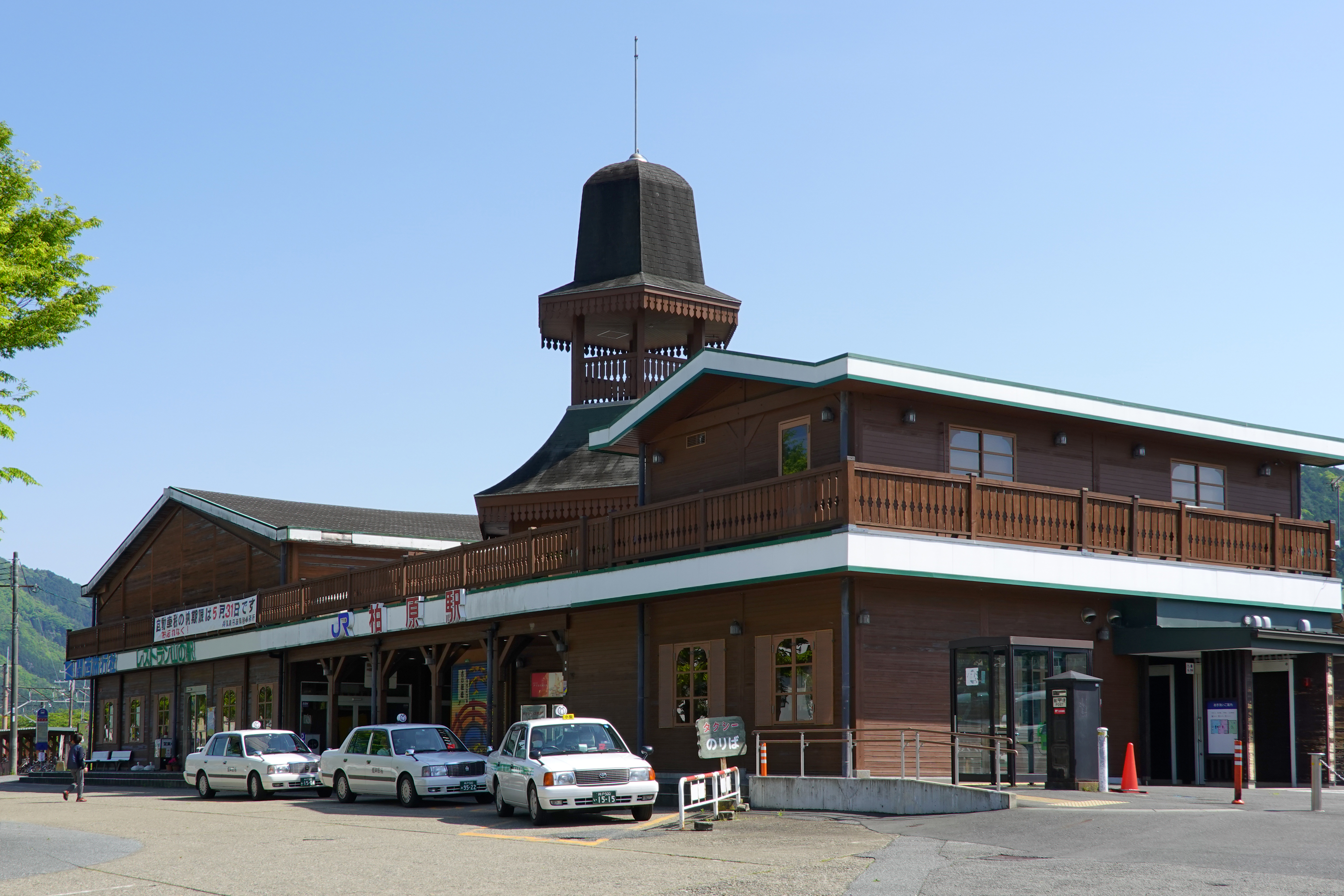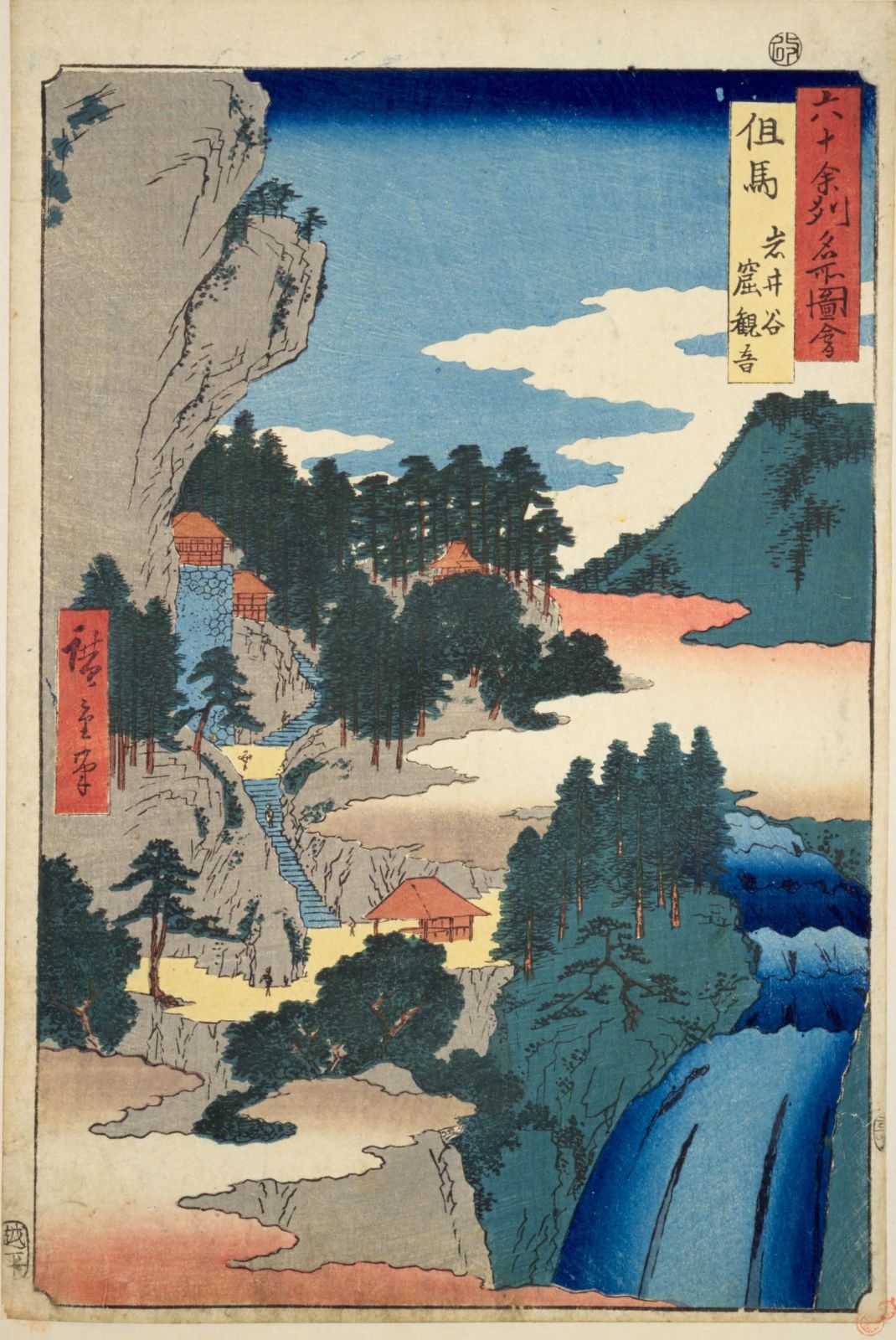|
Kuroi Castle
was a Sengoku period Japanese castle located in what is now the Kasuga-cho neighborhood of the city of Tamba, Hyōgo, Tamba Hyōgo Prefecture, Japan. It was also called or . Famous as the birthplace of Lady Kasuga, the wet nurse of Tokugawa Iemitsu, it ruins have been protected as a Historic Sites of Japan, National Historic Site since 1989. History Kuroi Castle is located on a 350-meter mountain at the middle of Hikami basin, protected on three sides by rivers. the valley is a cul-de-sac to the northwest of the Sasayama basin, which contained Sasayama Castle. Spreading across three ridges of the mountain, the castle was one of the largest in Tanba Province, along with Yakami Castle and Yagi Castle. A fortification was originally built in this location in the early Muromachi period by the Akamatsu clan, who ruled the area for around 120 years. It then came into the hands of the Ogino clan, a cadet branch of the Akai clan, who in turn were a cadet branch of the Inoue clan, origin ... [...More Info...] [...Related Items...] OR: [Wikipedia] [Google] [Baidu] |
Tamba, Hyōgo
file:2014-11-24 Sekiganji 石龕寺 DSCF4750.jpg, Autumn foliage at Sekigan-ji is a Cities of Japan, city in Hyōgo Prefecture, Japan. , the city had an estimated population of 62,152 in 26090 households and a population density of 130 persons per km2. The total area of the city is . Geography Tamba is located in an inland basin at an average elevation of 100 meters above sea level in the eastern part of the prefecture. It is located in the mountains between the Seto Inland Sea and the Sea of Japan. The uppermost stream of the Kako River system and the uppermost stream of the Yura River (Japan), Yura River system, flow through the city, which has the lowest central watershed in Japan except for Hokkaido. The 35 degree east longitude meridian passes through the city. Neighboring municipalities Hyōgo Prefecture *Asago, Hyōgo, Asago *Nishiwaki, Hyōgo, Nishiwaki *Taka, Hyōgo, Taka *Tamba-Sasayama Kyoto Prefecture *Fukuchiyama, Kyoto, Fukuchiyama Climate Tamba has a humid subtropi ... [...More Info...] [...Related Items...] OR: [Wikipedia] [Google] [Baidu] |
Yagi Castle
270px, Aerial photograph showing the relative locations of the old castle, new castle and Kamakura-period mansion is a late Kamakura period Japanese castle located in the Yōka neighborhood of the city of Yabu, Hyōgo Prefecture, Japan. Its ruins have been protected as a National Historic Site since 1997. The ruins are regarded as historically important, as the site includes the traces of a Kamakura period feudal mansion, Muromachi period mountain castle with clay walls, and the ruins of a Sengoku period castle with stone walls. History Yagi Castle is situated in a strategic border area between the Kansai region and the San'in region, overlooking the ancient San'in highway connecting Tajima Province with Inaba Province. The castle has town locations. One is at Mount Tsuchiyama, with an elevation of 409 meters (which is called the "Yagi Kojō", or "old Yagi Castle") and the other at Mount Shiroyama, with an elevation 303 meters, with the two areas connected by a 450-meter ridge. ... [...More Info...] [...Related Items...] OR: [Wikipedia] [Google] [Baidu] |
Takeda Clan
The was a Japanese samurai clan active from the late Heian period until the late 16th century. The clan was historically based in Kai Province in present-day Yamanashi Prefecture. The clan reached its greatest influence under the rule of Takeda Shingen, one of the most famous rulers of the period. History Origin The Takeda are descendants of the Emperor Seiwa (858–876), the 56th Emperor of Japan, and are a branch of the Minamoto clan (Seiwa Genji), by Minamoto no Yoshimitsu (1056–1127), son of the '' Chinjufu-shōgun'' Minamoto no Yoriyoshi (988-1075), and brother to the famous Minamoto no Yoshiie (1039–1106). Minamoto no Yoshikiyo (1075–1149), son of Yoshimitsu, was the first to take the name of Takeda, which he took when his father granted him Takeda domain in Hitachi Province; thereafter, he was known as Takeda Yoshikiyo. Kamakura to early Azuchi–Momoyama periods In the 12th century, at the end of the Heian period, the Takeda family-controlled Kai Province. ... [...More Info...] [...Related Items...] OR: [Wikipedia] [Google] [Baidu] |
Oda Nobunaga
was a Japanese ''daimyō'' and one of the leading figures of the Sengoku period, Sengoku and Azuchi-Momoyama periods. He was the and regarded as the first "Great Unifier" of Japan. He is sometimes referred as the "Demon Daimyō" and "Demon King of the Sixth Heaven". Nobunaga was an influential figure in Japanese history and is regarded as one of the three great unifiers of Japan, along with his Affinity (medieval), retainers, Toyotomi Hideyoshi and Tokugawa Ieyasu. Nobunaga paved the way for the successful reigns of Hideyoshi and Ieyasu by consolidating power, as head of the very powerful Oda clan, through a series of wars against other ''daimyō'' beginning in the 1560s. The period when Nobunaga and Hideyoshi were in power is called the Azuchi–Momoyama period. The name "Azuchi–Momoyama" comes from the fact that Nobunaga's castle, Azuchi Castle, was located in Azuchi, Shiga; while Fushimi Castle, where Hideyoshi lived after his retirement, was located in Momoyama. Nob ... [...More Info...] [...Related Items...] OR: [Wikipedia] [Google] [Baidu] |
Konosumiyama Castle
was a Muromachi to Sengoku period Japanese castle located in the Izushi neighborhood of the city of Toyooka, Hyōgo Prefecture, Japan. Its ruins, along with the ruins of nearby Arikoyama Castle have been protected as a National Historic Site since 1934 under the designation "Yamana clan castle ruins". History Konosumiyama Castle is located approximately two kilometers north of the center of former Izushi city and three kilometers from the southeast edge of the Toyooka basin in northern Hyogo. The location controlled the ancient San'in highway connecting the Kinai region of Japan with the San'in region and was near the political and economic center of Tajima Province. The area came under the control of the Yamana clan, a cadet branch of the Nitta clan in the Muromachi period. The Yamana clan had close relations with the Ashikaga shogunate and was one of four clans with hereditary rights to the position of ''Samurai-dokoro''. The Yamana leveraged their position to eventually ... [...More Info...] [...Related Items...] OR: [Wikipedia] [Google] [Baidu] |
Takeda Castle
was a Sengoku period Japanese castle located in the Wadayama neighborhood of the city of Asago, in the northern part of Hyōgo Prefecture, Japan. It is located north of Himeji, and north-west of Kyoto, and is situated some 353 metres above sea level It is often referred to locally as the "Machu Picchu of Japan". The castle was destroyed during the Sengoku period, only its foundations and stone walls remain. The ruins have been protected as a National Historic Site since 1943. History Takeda Castle is located on Mount Shiroyama at a strategic location commanding the intersection of the San'indo highway from Tanba to Inaba Province connects with the road south to Harima Province and the Seto Inland Sea. The castle is also close to the Ikuno mine, one of the largest silver mines in Japan during the Muromachi period. The area came under the control of the Yamana clan, a cadet branch of the Nitta clan, in the Muromachi period. The Yamana clan had close relations with the Ashi ... [...More Info...] [...Related Items...] OR: [Wikipedia] [Google] [Baidu] |
Tajima Province
was a Provinces of Japan, province of Japan in the area of northern Hyōgo Prefecture. Tajima bordered on Tango Province, Tango and Tanba Province, Tanba to the east, Harima Province, Harima to the south, and Inaba Province, Inaba to the west. Its abbreviated form name was . In terms of the Gokishichidō system, Tajimao was one of the provinces of the San'indō circuit. Under the ''Engishiki'' classification system, Tajima was ranked as one of the "superior countries" (上国) in terms of importance, and one of the "near countries" (近国) in terms of distance from the capital. The provincial capital was located in what is now the city of Toyooka, Hyōgo, Toyooka. The ''ichinomiya'' of the province is the Izushi Shrine also located in Toyooka. The area of the province was 2099.01 square kilometers. History Early history The early history of the Tajima region is uncertain. There appear to have been two power centers. The Tajima ''Kuni no miyatsuko'' ruled in eastern Tajima ( ... [...More Info...] [...Related Items...] OR: [Wikipedia] [Google] [Baidu] |
Yamana Clan
The was a Japanese samurai clan which was one of the most powerful of the Muromachi period (1336–1467); at its peak, members of the family held the position of Constable ('' shugo'') over eleven provinces. Originally from Kōzuke Province, and later centered in Inaba Province, the clan claimed descendance from the Seiwa Genji line, and from Minamoto no Yoshishige in particular. The clan took its name from the village of Yamana in present-day Gunma Prefecture. They were valued retainers under Minamoto no Yoritomo, and counted among his '' gokenin''. The Yamana were among the chief clans in fighting for the establishment of the Ashikaga shogunate, and thus remained valued and powerful under the new government. They were Constables of five provinces in 1363, and eleven a short time later. However, members of the Yamana clan rebelled against the shogunate in the Meitoku Rebellion of 1391 and lost most of their land. Yamana Sōzen (1404 – 1473), likely the most famous me ... [...More Info...] [...Related Items...] OR: [Wikipedia] [Google] [Baidu] |
Onin War
Onin may refer to: * Ōnin, a Japanese era ** Ōnin War * Onin peninsula, on the Bomberai Peninsula of Indonesian Papua * Onin language, an Austronesian language spoken on the peninsula {{Disambiguation ... [...More Info...] [...Related Items...] OR: [Wikipedia] [Google] [Baidu] |
Shugo
, commonly translated as ' ilitarygovernor', 'protector', or 'constable', was a title given to certain officials in feudal Japan. They were each appointed by the shogun to oversee one or more of the provinces of Japan. The position gave way to the emergence of the daimyo (military feudal lords) in the late 15th century, as ''shugo'' began to claim power over lands themselves, rather than serving simply as governors on behalf of the shogunate. History The post is said to have been created in 1185 by shogun Minamoto no Yoritomo to aid the capture of Yoshitsune, with the additional motivation of extending the rule of the Minamoto shogunate government throughout Japan. The ''shugo'' (military governors) progressively supplanted the existing ''kokushi'' (civil governors), who were appointed by the Imperial Court in Kyoto. Officially, the ''gokenin'' in each province were supposed to serve the ''shugo'', but in practice, the relationship between them was fragile, as the gokenin were ... [...More Info...] [...Related Items...] OR: [Wikipedia] [Google] [Baidu] |
Hosokawa Clan
The is a Japanese samurai kin group or Japanese clan, clan. The clan descends from the Seiwa Genji, a branch of the Minamoto clan, and ultimately from Emperor Seiwa, through the Ashikaga clan. It produced many prominent officials in the Ashikaga shogunate's administration. In the Edo period, the clan was one of the largest landholding daimyo families in Japan. The current clan head Morihiro Hosokawa served as Prime Minister of Japan. Muromachi and Sengoku periods Ashikaga Yoshisue, son of Ashikaga Yoshizane, was the first to take the surname of Hosokawa. Hosokawa Yoriharu, a Hosokawa of the late Kamakura period, fought for the Ashikaga clan against the Kamakura shogunate. Another, Hosokawa Akiuji, helped establish the Ashikaga shogunate. The clan wielded significant power over the course of the Muromachi period, Muromachi (1336–1467), Sengoku period, Sengoku (1467–1600), and Edo periods, moving, however, from Shikoku, to Kinai, and then to Kyūshū over the centuries. The c ... [...More Info...] [...Related Items...] OR: [Wikipedia] [Google] [Baidu] |



